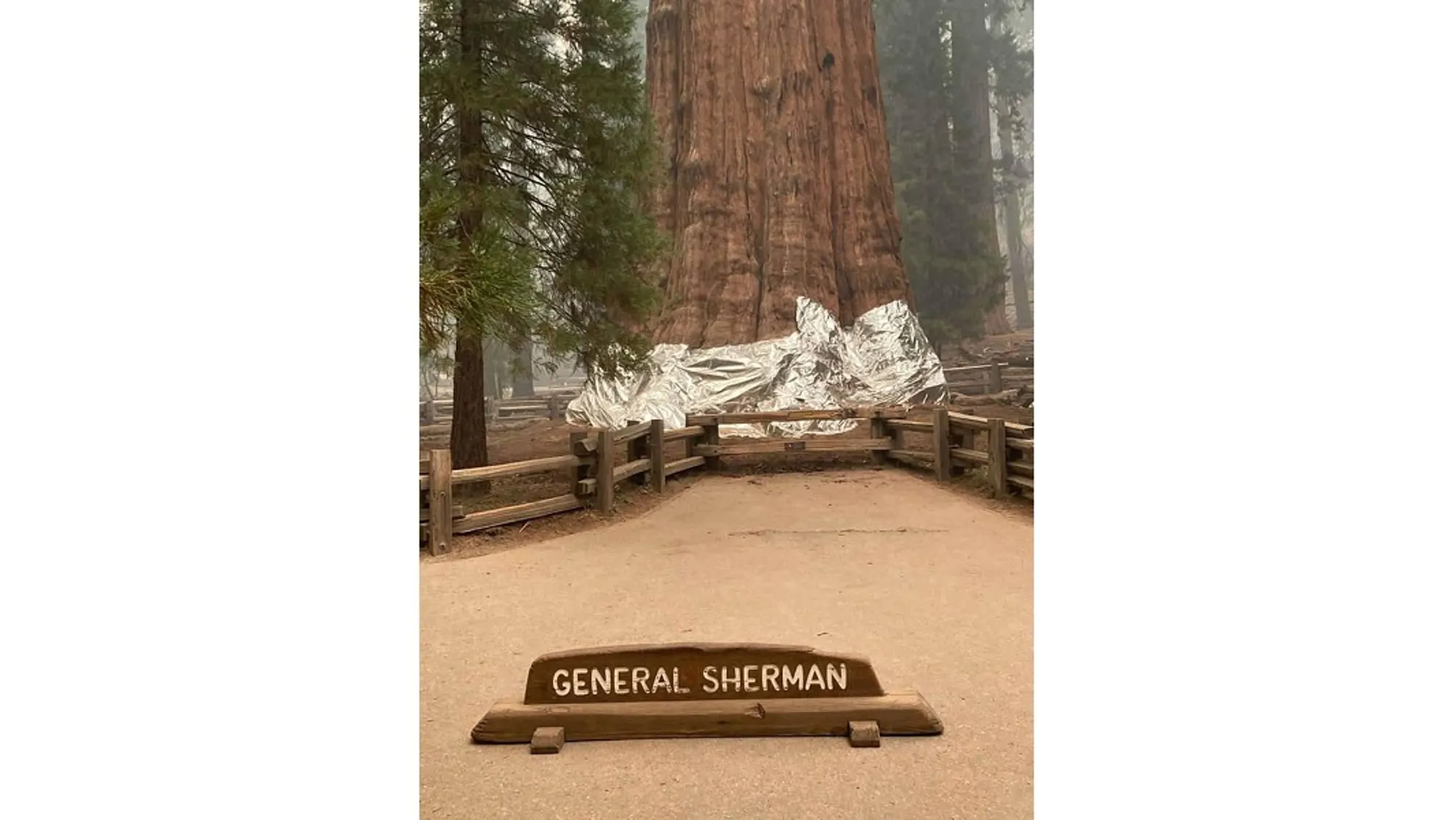The KNP Complex fires in Sequoia National Park have entered the famed Giant Forest area, home to the General Sherman and other cherished towering sequoias.
September 19, 2021 – By Michael Cabanatuan – Source San Francisco Chronicle
Sep. 18—Flames from the KNP Complex fires in Sequoia National Park entered the famed Giant Forest area, home to the General Sherman and other named and cherished towering sequoias Friday.
Mark Garrett, a fire information officer, told The Chronicle he was heading to the grove of sequoias when he had to turn around as fire crossed the General’s Highway and neared the Giant Forest. Some of the crews clearing brush and doing controlled burns also fled the area, he said.
“It looks like the two fires merged into one and are going into Giant Forest,” he said, referring to the Colony and Paradise fires that make up the KNP Complex in the national park and surrounding national forests.
The General Sherman and the other tallest and most famous trees are partially wrapped in foil and encircled by protective barriers carved into the earth.
Fire officials said they were confident that the Giant Forest, about 3 square miles and containing about 2,000 sequoias, is well-protected against the flames with the floor of the forest cleared of most debris and a long history of prescribed burns to reduce fuel in the area.
“The General Sherman is wrapped and so are a lot of the other named trees,” Garrett said. “The others are at least raked and cleared around the bases so the fires won’t burn up to the canopies.”
During a town hall meeting in Three Rivers ( Tulare County), a fire official said firefighters were concerned about preventing the roots and bases of the giant trees as well as existing burn scars on their bark — known as “cat faces” — from catching fire.
The fire is moving northeast toward the Lodgepole area, where the park has a visitor center, campground, restaurants and housing for park employees, who’ve been evacuated. Structure protection crews have been hard at work in the area for the past couple of days, Garrett said.
Fire officials assured residents living south of the fire that while the tall trees are getting the most media attention, they’re prepared to evacuate communities and protect homes and businesses if the winds shift and the fire shifts direction.
The KNP Complex, a collection of fires ignited by lightning Sept. 10, had consumed 11,365 acres, growing by more than 4,000 acres in a day, and was 0% contained at midday Friday. The flames continued to advance toward the grove of giant sequoias and were expected to burn into the forest Saturday or Sunday, according to firefighters.
The General Sherman stands 275 feet tall and has a diameter of about 36 feet at its base. It takes about 20 people joining hands to encircle it. While its rank among the titans of trees is often debated, it is considered the largest tree by volume and the world’s biggest sequoia. Some California coastal redwoods are taller. The General Sherman is estimated to be 2,300 to 2,700 years old.
Fire crews on Thursday wrapped the base of the General Sherman and some other sequoias in the Giant Forest area with an aluminum insulation wrap to protect them from the flames. The trees have apparently been wrapped all the way around and up about 10 feet, though photographs released by the National Park Service show only part of the wrapping.
Wrapping the giant trees around their bases helps prevent damage to the cambium, a layer of the tree inside its thick bark, by protecting it against lingering fire burning on the ground, said Joanna Nelson, Save the Redwoods League’s director of science and conservation planning.
In addition to the foil wraps, crews have also dug protective lines around the giant trees and set controlled fires to clear some of the underbrush, debris and dried fuel in the 5-square-mile Giant Forest, home to about 2,000 soaring sequoias and the national park’s top attraction.
Steve Bumgardner, a videographer and former ranger, firefighter and tour guide in the park for more than 20 years, said the storied grove of trees is likely to survive the fire because the area has been well managed, including with controlled fires, for decades.
“If any grove can handle a fire it’s the Giant Forest,” he said. “It has had 50 years of prescribed burns.”
Nelson declined to speculate on the fate of the General Sherman but said she expects it will be well protected.
“The General Sherman has the aluminum wrap and will be defended by firefighters,” Nelson said. “There are specific trees that call out for special protection. When you’re famous as a tree, you get special care.”
But the weather appears to be changing, with onshore winds from the west picking up speed and pushing the flames, according to the Forest Service. Afternoon and evening winds of 15 to 25 mph are forecast with gusts of up to 40 mph.
To the south of the KNP Complex in Sequoia National Forest, the Windy Fire on Friday had grown to 6,849 acres with 0% containment. Residents of the Tule River Indian Reservation and areas nearby were urged to monitor the fire’s progress.
That fire has prompted evacuation orders for two communities and burned into a portion of the Peyrone Sequoia Grove, forest officials reported — though because the area is inaccessible, an assessment of the damage to giant sequoia trees may take days to complete.
In northeastern California, the Dixie Fire burning across five counties was at 960,641 acres and 88% contained on Friday. The Caldor Fire near Lake Tahoe was 218,876 acres and 71% contained.
(c)2021 the San Francisco Chronicle
Visit the San Francisco Chronicle at www.sfchronicle.com
Distributed by Tribune Content Agency, LLC.
